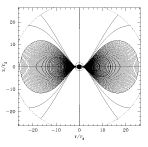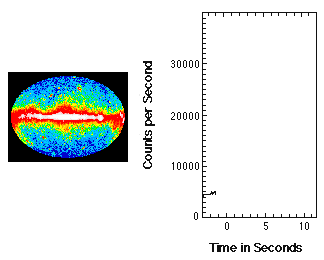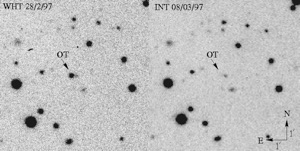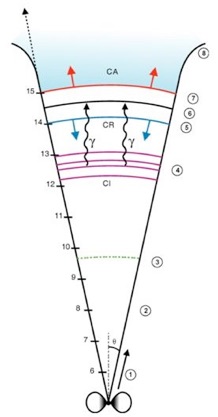A theoretical scenario : how to produce a gamma-ray burst ?
Many studies on gamma-ray bursts in several international teams (including our team at IAP) since 1997 have led to the following theoretical scénario : (1) an initial cataclysmic event (for instance the gravitational collapse of a very massive star) leads to the formation of a stellar mass black hole surrounded by an accretion disk; (2) this system black hole+disk, via a mechanism which is poorly understood, ejects material at velocities very close to the speed of light (items 1 & 2 on the sketch above). At large distance from the central source, this ejecta becomes transparent (item 3) and can convert a fraction of its kinetic energy into radiation; (3) shock waves form in this relativistic jet (internal shocks, item 4). Shock accelerated electrons radiate the gamma-rays observed during the burst itself; (4) the relativistic jet is eventually decelerated by the surrounding medium. Two new shock waves form: a very violent shock that propagates within the external medium (external shock, item 7) and a reverse shock (item 5) that crosses the jet. The shocked external medium and the jet are separated by a contact discontinuity (item 6).The afterglow is produced during this deceleration phase. Eventually, it becomes non-relativistic and expands laterally (item 8). In the long term, it is probably difficult to distinguish it from a supernova remnant. Approximate distances are given on the left side of the sketch by the logarithm of the distance in meters (e.g. 9 stands for 1 000 000 000 meters).
Modélisation physique des sursauts gamma
Les travaux menés à l’IAP portent sur les différents points de ce scénario : (1) concernant le “moteur central” (système trou noir+disque), nous avons étudié la stabilité dynamique du système et montré qu’il pouvait survivre assez longtemps pour permettre à la suite du scénario d’opérer. Nos idées théoriques ont ensuite été vérifiées à l’aide de simulations hydrodynamiques en relativité générale effectuées en collaboration avec J.A. Font-Roda, Univ. Valencia (références 1, 9, 11 & 15 dans ma liste de publications); (2) concernant la phase d’éjection, nous avons développé un modèle simple de vent magnétisé et cherché à contraindre sous quelles conditions un jet relativiste peut être produit (référence 8 dans ma liste de publication). Pendant mon postdoc au MPA, Garching, avec H. Spruit j’ai caractérisé de manière générale le rôle que peut jouer le champ magnétique et en particulier le rôle potentiel de la reconnection magnétique pour l’accélération du jet (références 5 & 6 dans ma liste de publications) ; (3) concernant les phases d’émission du sursaut proprement dit, nous avons à l’IAP une expertise reconnue sur la phase des chocs internes, pour laquelle nous avons développé un modèle très détaillé. Il permet de simuler des sursauts synthétiques complets (courbes de lumière et spectres) et de les comparer ainsi aux observations de manière approfondie (références 2, 4, 14, 17, 24, 27, 29, 32, 34, 36 & 47 dans ma liste de publications). Nous avons étudié spécifiquement la propagation des photons de haute énergie pour obtenir des contraintes sur le facteur de Lorentz du jet à partir des observations de Fermi (référence 38 dans ma liste de publications). Nous avons étudié dès 2002 l’émission, dite photosphérique, produite au moment où le jet devient transparent à la fin de la phase d’accélération, qui a sans doute été détectée depuis par Fermi (références 10, 35, 42 & 44 dans ma liste de publications) ; (4) concernant la phase de décélération, nous travaillons sur un modèle un peu différent du modèle le plus standard, dans lequel le choc en retour, au lieu du choc externe, joue une rôle dominant pour produire la rémanence (références 3, 26, 33 & 41 dans ma liste de publications). Un autre modèle alternatif fait l’hypothèse que l’énergie libérée par la source est uniquement sous forme électromagnétique (Blandford & Lyutikov, 2003). Nous avons calculé la forme des rémanences dans ce cas (référence 21 dans ma liste de publications). Dans le cadre du modèle le plus standard, nous avons calculé l’effet d’un profil de densité “réaliste” dans le milieu extérieur (référence 19 dans ma liste de publications). De manière générale, nous avons proposé plusieurs tests pour distinguer les sites et mécanismes d’émission dans les sursauts (références 25, 37, 39, 40, 45 & 46 dans ma liste de publications).
En ce qui concerne les sursauts gamma comme population cosmologique, nous avons été les premiers à montrer que le taux de sursauts gamma ne suivait pas le taux de formation stellaire : l’efficacité des étoiles à produire des sursauts gamma est plus élevée dans l’Univers jeune (référence 23 dans ma liste de publications).
Modelling gamma-ray bursts
Different contributions to the theoretical scenario described above have been made in our team at IAP: (1) we have studied the dynamical stability of the “central engine” (black hole+disk) and shown that it could survive long enough for the following steps in the scenario to operate. Our theoretical ideas have been verified using hydrodynamical simulations in general relativity in collaboration with J.A. Font-Roda, Univ. Valencia (references 1, 9, 11 & 15 in my publication list); (2) concerning the relativistic ejection phase, we have developed a toy model for a magnetized wind and constrained the physical conditions necessary to pruduce an ultra-relativistic jet (reference 8 in my publication list). During my postdoc at MPA, Garching, I have studied with H. Spruit the role of the magnetic field in gamma-ray bursts and in particular how magnetic dissipation (reconnection) could contribute in a significant way to accelerate the jet (references 5 & 6 in my publication list); (3) we have made many important contributions to the study of the prompt emission by internal shocks and have developed a very detailed model for this phase. We can simulate full synthetic bursts (lightcurves and spectra) and compare their properties to observations (references 2, 4, 14, 17, 24, 27, 29, 32, 34, 36 & 47 in my publication list). Since 2002, we have also studied the photospheric emission produced when the jet becomes transparent at the end of the acceleration phase, which is now observed by Fermi (references 10, 35, 42 & 44 in my publication list); (4) concerning the deceleration phase, we are working on a model which is slightly different from the most standard version where the afterglow emission is produced in the external shock. We assume that the reverse shock is radiatively dominant (references 3, 26, 33 & 41 in my publication list). Blandford & Lyutikov (2003) have proposed a more alternative model where the energy initially released by the central source is purely magnetic. We have computed the expected afterglows in this case (reference 21 in my publication list). In the framework of the most standard external shock model, we have computed the effect of a realistic profile for the density of the external medium (reference 19 in my publication list). More generally, we have proposed several tests to distinguish among the possible emission sites/mechanisms in gamma-ray bursts (references 25, 37, 39, 40, 45 & 46 in my publication list).
Regarding gamma-ray bursts as a cosmological population, we have been the first to prove that the gamma-ray burst rate was not following the stellar formation rate : the efficiency of stars to produce gamma-ray bursts is larger in the early Universe (reference 23 in my publication list).
Autres travaux reliés aux sursauts gamma
Nous participons activement au projet de satellite franco-chinois SVOM, qui sera lancé vers 2020 et sera consacré à l’étude multi-longueurs d’onde des sursauts gamma et de leurs rémanences, avec un accent sur la recherche de sursauts très distants (voir les différents liens sur le projet SVOM).
Other works related to gamma-ray bursts
We are also participating actively in the preparation of the French-Chineze sateliite SVOM, to be launched ~2020. This mission is devoted to the multi-wavelength study of gamma-ray bursts and their afterglows, with a special interest in detecting very distant bursts (see the specific links on SVOM).
Collaborateurs principaux / Main collaborators
Robert Mochkovitch (IAP) & Elisabeth Vangioni (IAP)
Romain Hascoët (Columbia), Zeljka Bosnjak (Univ. Rijeka), Sylvain Guiriec (GSFC), Frédéric Piron (LUPM), Stéphane Goriely (ULB), Andrei Beloborodov (Columbia), Guillaume Dubus (IPAG), Joe Silk (IAP), Keith Olive (Univ. Minnesota)
Former collaborators: Emmanuel Rollinde (IAP), Franck Genet, Lucas Z. Uhm (UNLV), Elena Rossi (Obs. Leiden), John Eldridge (IoA), Toni Font (Univ. Valencia), M.A. Perez-Garcia (Univ. Salamanca), Henk Spruit (MPA).









